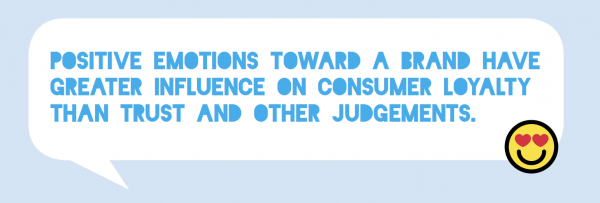March 25th, 2018
Media Reporting: How We Determine If Media Works
So great, we’ve made this beautiful [insert creative here]. The client loves it. We send it out to sail the abyss known to us mere mortals as the internet. … Now what?
Believe it or not, every time we place an ad, there is a boatload of information we can see that goes beyond the number of impressions or clicks. But what client wants to spend an afternoon looking at a chart full of numbers that don’t even make sense? How do you figure out what is really important? And what’s the point anyway?
Great questions.
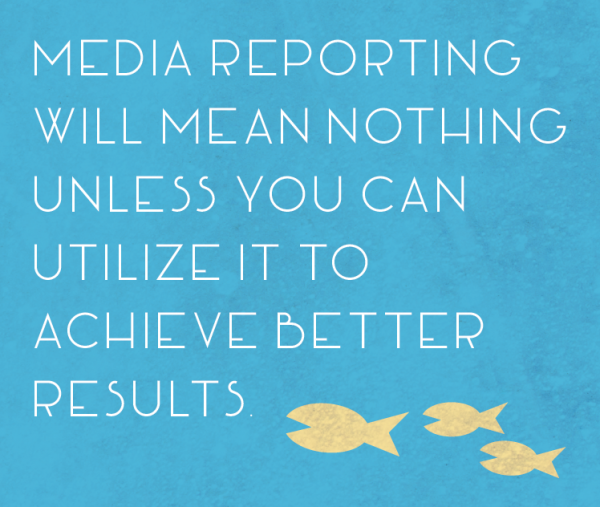 The absolute best thing I can teach you about media reporting is that it will mean nothing unless you can utilize it to achieve better results. These reports tell us all kinds of things. They sometimes confirm what we already think to be true – that we correctly assumed a trend and the ads are performing as predicted. Or the opposite may happen and the ad we liked the least is outperforming the others. This data leads to further questions, which give us insight for how to move forward throughout the campaign, or future endeavors.
The absolute best thing I can teach you about media reporting is that it will mean nothing unless you can utilize it to achieve better results. These reports tell us all kinds of things. They sometimes confirm what we already think to be true – that we correctly assumed a trend and the ads are performing as predicted. Or the opposite may happen and the ad we liked the least is outperforming the others. This data leads to further questions, which give us insight for how to move forward throughout the campaign, or future endeavors.
The most efficient way for us to help you optimize performance and achieve your campaign goals is to bring us into the planning process. Help us help you identify your desired performance indicators, be it video completions, or purchases made. With these performance metrics in mind, we know what to look for when we see all these charts full of numbers, as well as how to identify those figures that will make the biggest difference for your campaign moving forward.
March 25th, 2018
The Keys to a Happy Creative and Media Marriage
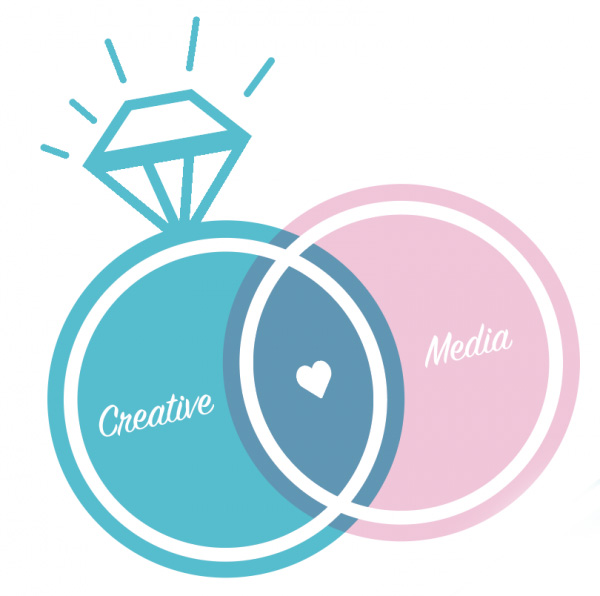 I’m a creative. But I love media. In fact, I previously co-led an interdisciplinary team that combined members from the digital, creative and media departments. To be successful in this ever-changing world, a healthy marriage of these disciplines is an absolute necessity. A creative idea is only as strong as the media that supports it. And a media buy can only be effective if the creative is both compelling and engaging.
I’m a creative. But I love media. In fact, I previously co-led an interdisciplinary team that combined members from the digital, creative and media departments. To be successful in this ever-changing world, a healthy marriage of these disciplines is an absolute necessity. A creative idea is only as strong as the media that supports it. And a media buy can only be effective if the creative is both compelling and engaging.
So, what exactly are the keys to a happy creative–media marriage? It’s as simple as following these easy recommendations.
Start talking early. And often.
This may sound like a repeat, but it’s important. The earlier the creative and media teams get together, the better. The absolute worst possible outcome is a creative idea having to be retrofit into a media buy that doesn’t support it, or media trying to facilitate a creative concept in a buy for which it doesn’t make sense.
Research. Research. Research.
Every day, publishers and media companies are creating new and exciting ways to reach your target audience. Try to track, follow, anticipate and act upon new technologies and possibilities.
No role is more important than the other.
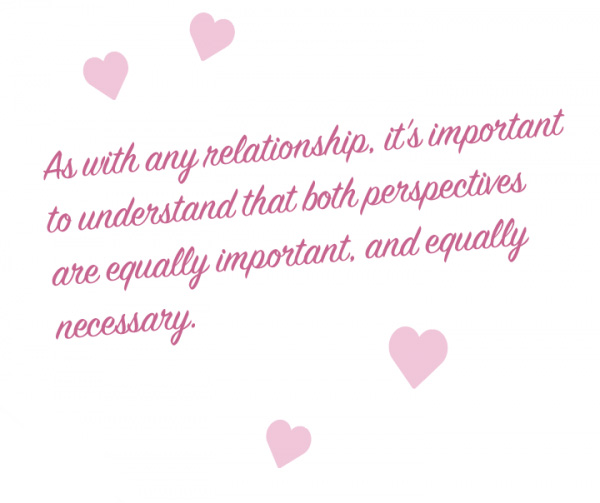 As with any relationship, it’s important to understand that both perspectives are equally important, and equally necessary.
As with any relationship, it’s important to understand that both perspectives are equally important, and equally necessary.
Try a lot. See what sticks.
Trying new things can seem risky. But nobody ever exceeded expectations by doing what’s always been done. Try allocating part of the budget to something new, even if it’s small.
As a campaign wears on, don’t forget to work together to figure out new ways to optimize the work – new copy, imagery, targeting tactics or vendors. This greatly increases the ads’ effectiveness and performance.
March 25th, 2018
Purchasing Media and Artificial Intelligence
Artifical Intelligence is weaving its way into everything we do. AI like Alexa, Siri and Bixby have been integrated into everything from our phones to appliances and now vehicles. These AIs are getting smarter each day, learning our preferences and responding to our questions.
Media buying and purchasing is no exception. Marketers can leverage these AI learnings and create opportunities to interact with customers. For example:
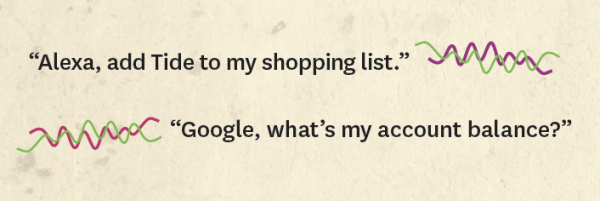
As marketers, we have the opportunity to assist customers in completing these tasks.
Creative teams start by ensuring that product names are easy for customers to say and voice assistants to understand/repeat back.
Media teams then work hand in hand with creative and development teams to use the skill-development kits available to integrate into the AI channels.
Media teams can also reach out through connections to the AI corporations to secure integrated placements. There are ways to be integrated at no cost, and, similar to search, there are opportunities to pay to get customers to say the brand.
We have the opportunity to focus on simplicity and make our clients and brands easier to be recommended, utilized and accessed by current and prospective customers. AI shouldn’t be scary, but rather embraced as an opportunity to help us succeed.
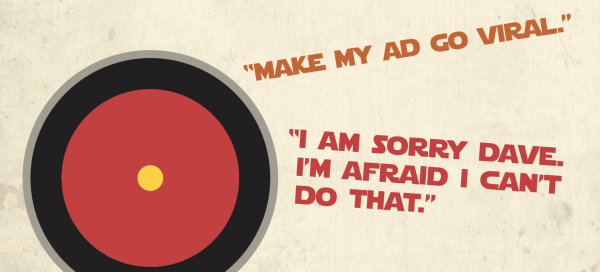
March 25th, 2018
A Smart Search Strategy Starts with The Right Match
The seasons have changed and so has your inventory, so how do you let people know that you have exactly what they are looking for? Insert Search Engine Marketing here – or better known as SEM or Google Ad Words. SEM is the perfect tactic for reaching people who are searching Google for the same products and services that you offer. But, trying to manage SEM on your own can be overwhelming and costly, so here are a few simple tips.
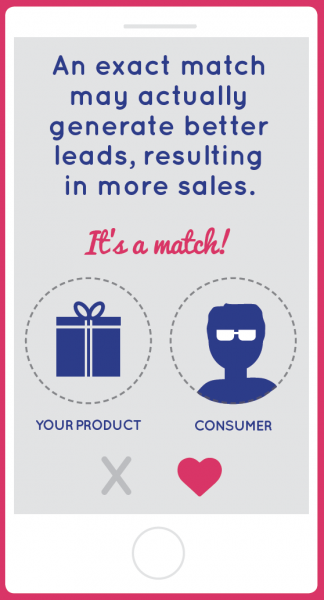 Determine the best type of match.
Determine the best type of match.
When selecting your keywords, you’re going to have to choose between a broad, phrase or exact match, so think about which type best fits your goals. For example, while a broad match may get you more impressions or clicks, it’s possible that an exact match may actually generate better leads, resulting in more sales.
Make the most of your keywords.
When creating search ads, be sure to include keywords in your titles, as well as in your description. Also, Google recommends that you run three display ads with your search campaign. This gives you the opportunity to use more keywords and reach more people.
Monitor your performance.
You will want to monitor a keyword’s impressions, clicks and cost. Don’t just set it and forget it. Look at the quality score and ranking of a keyword, as this affects where Google places your ad within the search results. Then take these insights into how people are searching for your products and services and use them to come up with new keywords and updates to your ads.

March 25th, 2018
Five Media Predictions for 2018
1. Facebook Will Maintain Dominance for Now
Last year, Facebook accounted for 23% of total U.S. digital ad spending. But, according to eMarketer projections, it will hit a new record in 2018, taking in $1 of every $10 spent on all advertising – digital and non-digital combined.
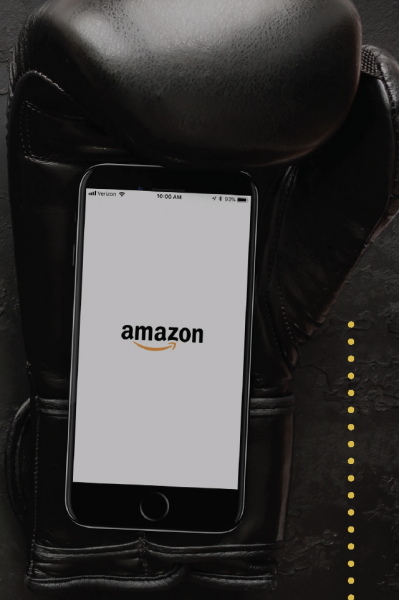 2. Amazon Will Take Off the Gloves
2. Amazon Will Take Off the Gloves
While Google and Facebook are the behemoths in the advertising market, we expect 2018 to be the year Amazon will roll out an upgraded ad platform that can compete with Facebook and Google’s duopoly, taking full advantage of its 180 million U.S. visitors each month.
3. Marketers Will Put the Story First
Storytelling engages, elicits active involvement and achieves better results. This is why more marketers in 2018 will seek innovative ways to tell their brand story. Expect to see a focus shift away from purchasing traditional ad units and more toward purchasing branded content.
4. Advertising Will Get Even More Personal
User data makes the ad world go round, and advertising will get increasingly personalized in 2018 as a result. AI will help us better curate the content we are most interested in across the fragmented media ecosystem and it will help make advertising even more targeted.
5. Blockchain Will Begin to Improve Digital Advertising
Effectiveness For advertisers, Blockchain can help stamp out bot clicks and other threats that can plague a campaign. Advertisers will know that it’s real people engaging with their ads, protecting the integrity of their campaign data and preventing wasted money. For consumers, their data will be better protected because of added security. And it could limit demographic information from being sold without authorization.
December 27th, 2017
Let’s Connect the Emotional Dots.
Look, it’s no secret. Emotions are behind almost every decision we make in life. And that’s precisely why tapping into emotions with your marketing and advertising is so important for the success of your brand.
Think about some of your favorite ads or marketing campaigns you’ve seen over the past few years. They probably made you laugh, cry, feel happy, feel … something. Right?
The power that comes with an emotional campaign is undeniable. But what’s harder to understand are the reasons behind how emotions are triggered and why certain campaigns and messages “work” better than others. And that’s what this issue of Thinking is all about.
Hope that makes you feel happy.
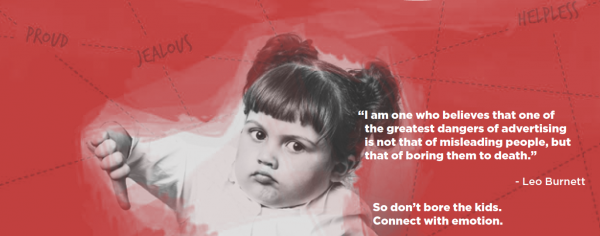
December 27th, 2017
Where have all the “Whys” gone?
How emotion differentiates an announcement from an ad.
Why do we need to concern ourselves with an emotional element in advertising? Aren’t the facts – the truth – persuasive enough?
If you’re honest with yourself, when’s the last time you bought anything purely – purely – based on the facts? When do you buy just because someone is hectoring you to do so?
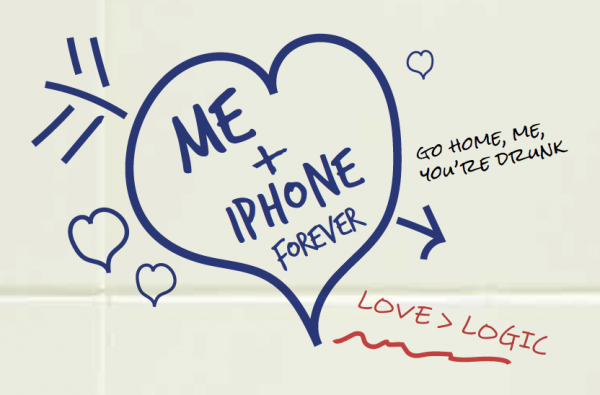 Why do we buy anything – a product or an idea? “I really need the new iPhone.” (Need is such a strong word.) “Lexus is a better car than a Toyota.” (Hint: it’s pretty much the same car – shared parts, different branding.) “Somebody’s going to win the lottery, might as well be me.” (Uh, no. Probably not.) There’s nothing rational about any of these statements, but they each tie into an underlying emotional desire that overrides logic.
Why do we buy anything – a product or an idea? “I really need the new iPhone.” (Need is such a strong word.) “Lexus is a better car than a Toyota.” (Hint: it’s pretty much the same car – shared parts, different branding.) “Somebody’s going to win the lottery, might as well be me.” (Uh, no. Probably not.) There’s nothing rational about any of these statements, but they each tie into an underlying emotional desire that overrides logic.
When it comes to creating impactful, memorable advertising, it’s important to remember this one thing: we’re all humans (except for those bots among you). It’s the emotions that we recall in life.
This might seem obvious, but time and again, when it comes to marketing their own products, otherwise bright and successful people start to recite a list of “whats”—facts, product details, specifications, logical reasons to buy—without addressing the “whys”—emotional drivers, desires, and deeper, often unspoken, needs.
Look at some of the iconic ads of the past 50 years: Apple’s “Think Different” campaign, Dove’s “Real Beauty,” Avis’ “We Try Harder,” even Keep America Beautiful and the tearful Iron Eyes Cody. Each one touched an emotional nerve, making us feel something – all while supporting a strong, single-minded message.
Emotion can be used in advertising in many ways – laughter, happiness, warmth, shock, even fear or sadness. When communication connects on an emotional level, we engage and remember. It’s what makes us care. So remember that when you start the list of “mandatories” on your next agency creative brief.

This isn’t limited to traditional media, such as print or TV. It’s why you’ll hear your agency talk about “experience” when describing their vision for your new website. It’s a good place to step back and take a serious look in the mirror, because, in my experience, most websites are page after page of “what” with very little “why.” Any tactic is only as effective as its emotional truth.
It’s not that facts aren’t important, but we use reason to support our desires. Once we’ve connected on an emotional level, rather than preached or spouted a laundry list of facts, we can present our idea and how it fits in with our customers’ lives and beliefs.

December 27th, 2017
Customer Relationships 101
How Motivational Emotions Create a Recipe for Social Success.
As Apu Gupta, CEO & Co-Founder at Curalate put it, “The Holy Grail for a marketer is not a transactional relationship but an emotional relationship with the consumer.”
As marketers, we know that emotions push us to act in all aspects of our lives. Think about the last time you made a decision. Whether it was buying a shirt, changing your brand of toothpaste or even purchasing a home, what made you decide to purchase? While it may not have seemed like it at the time, your decision was likely based on emotion.
Humans have been said to only have four basic emotions: happiness, sadness, fear/surprise and anger/disgust – all of which can be found on social media at any given time. Think about it. Every time we open up a social media app, we’re flooded with all of the above: wedding and baby announcements, an obituary of a loved one, and disasters (natural or otherwise) that grip the nation’s attention.
If you’ve ever felt your emotions shift in some way after scrolling through a social site, you’re not alone. Emotion via social media can be contagious – and powerful. Studies show that positive emotions toward a brand have greater influence on consumer loyalty than trust and other judgements, and harnessing the right emotions for your brand will work wonders for your social strategy.
Know Your Followers, Know Your Brand
Playing into emotions on social media is imperative for businesses, and it’s impossible to ignore how emotions influence our behavior. In order to generate and communicate genuine emotions, we must know the right emotions to share with each social following. To do this, we measure the type of content that generates the highest levels of engagement.
Case studies have shown that positive content is shared more quickly and widely than sad or negative content, largely because that “happy” content acts as a distraction from what’s often happening around the world and in the news. When it comes to social media campaigns, you can harness happiness not only to motivate people, but to condition them to be more likely to share your brand’s content in the long run. Case studies have also shown that positive news inspires other users within the same friend network to do the same as well, essentially creating a spiral of happiness.
Emotions that Make an Impact
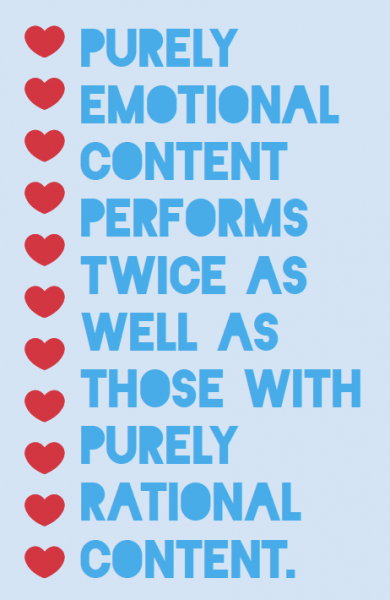
A study from IPA dataBANK showed that social campaigns with purely emotional content performed about twice as well as those with purely rational content (31% vs. 16%). Pair that with the fact that people intrinsically want to share things with friends, and you’re on your way to building an emotionally driven campaign that adds value to their daily lives through emotional
social media.
Facebook has publicly displayed just how important emotions are when, in 2016, they added emotional response capabilities to the Like button functionality. Ranging from love and laughter to sad and angry, Facebook is able to measure people’s emotional reactions to content shared on its platform. Additionally, users are promoted to type in a “Feeling/Activity” within the status of the Facebook homepage – clearly, Facebook has recognized the immense value of emotions on social media.
But what if the emotions go the other way? What if you find yourself and your brand in the middle of anger and fear? Crisis plans are a necessary part of any social strategy. This isn’t to say these types of emotions are always bad. In fact, they can be quite powerful, which is why we should use them wisely.
Emotions that Work for Your Brand
With all of this said, one can’t just begin publishing emotional content on social media without a plan. It’s a unique process to understand what resonates with your followers and what creates engagement. Use a testing period to understand what is – or isn’t – working. Be sure to use the social platform’s built-in reporting tools to glean the engagement that’s happening behind each post. And remember, quality always outperforms quantity.

December 27th, 2017
The Power of Sharing Sweetness
This summer, from July through September, in a food truck filled with a couple thousand pounds of honey, we conducted a sampling tour from the Midwest to the West Coast for the Sioux Honey Association Co-op.
Many consumer package goods companies travel around the country with sampling road shows because it’s a great way to engage with consumers and grow awareness for your brand. But we had a deeper objective: to share sweetness on behalf of the Co-op members, made up of nearly 300 beekeeper families aroundthe country.
Not only did we sample honey and share recipes, we paid it forward by sharing kindness at every stop. We sought out important initiatives in each community we visited and did what we could to help – just like a neighbor would. Just like the Sioux Honey beekeepers do. And we encouraged others to get involved, as well.
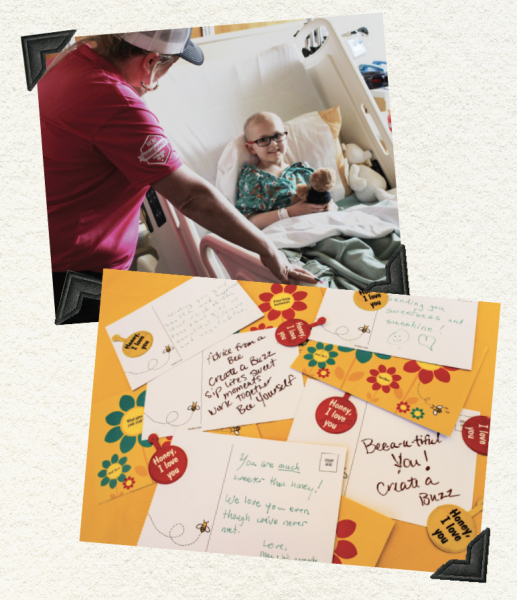
Denver
Our first stop was Denver where we connected with the Children’s Hospital of Colorado. At all our Denver area events, we encouraged people to write notes of cheer to the children. And Coloradans jumped at the chance. We collected hundreds and hundreds of cheer notes. We packaged them up with teddy bears and honey samples and delivered them to the Children’s Hospital.
Colorado Springs
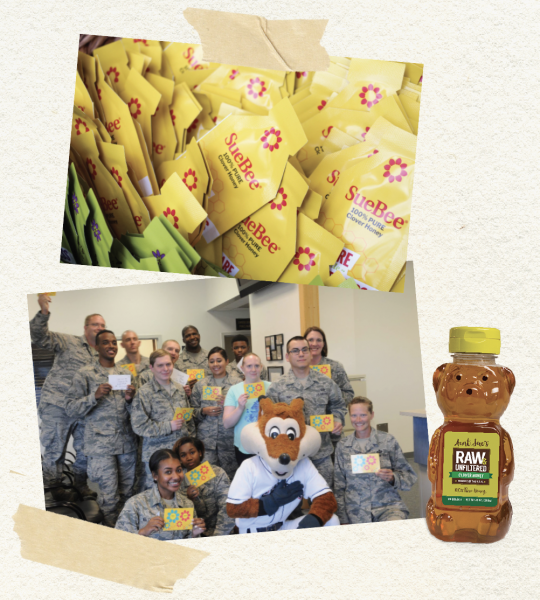 Each year, Colorado Springs is excited to welcome new recruits to the Air Force Academy. So we joined in by encouraging people to write notes at our events, then we delivered the notes and honey samples to incoming freshmen at the academy.
Each year, Colorado Springs is excited to welcome new recruits to the Air Force Academy. So we joined in by encouraging people to write notes at our events, then we delivered the notes and honey samples to incoming freshmen at the academy.
Phoenix
 Next up was Phoenix, which was experiencing a dangerous heat wave. The Phoenix Rescue Mission was in code red and desperately needed bottled water, so we were happy to help. And we also took to the trails to hand out water to those outside. In addition, we connected with an organization that helps area teachers by collecting donated teaching materials and classroom supplies.
Next up was Phoenix, which was experiencing a dangerous heat wave. The Phoenix Rescue Mission was in code red and desperately needed bottled water, so we were happy to help. And we also took to the trails to hand out water to those outside. In addition, we connected with an organization that helps area teachers by collecting donated teaching materials and classroom supplies.
San Diego
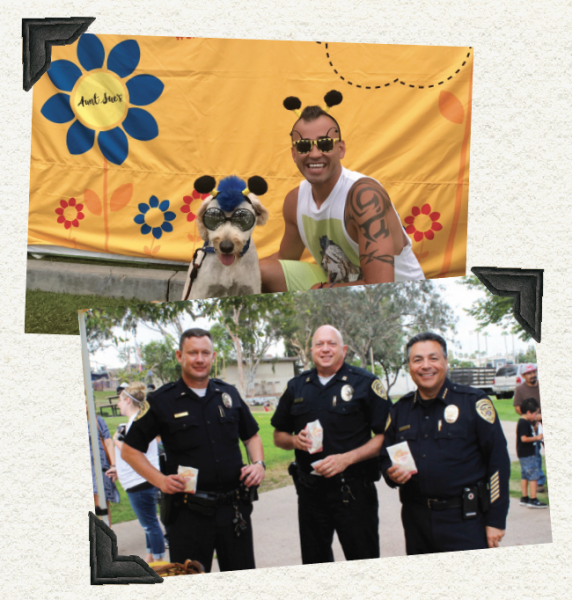 In the San Diego area, our four-legged friends were top of mind. So we partnered with Carla Butcher of Marley’s Pet Planet to make a huge batch of natural, health dog treats using Aunt Sue’s Raw & Unfiltered Honey. We donated hundreds of the healthy treats to the San Diego Humane Society and also handed a couple hundred out at the Surf Dog competition at Imperial Beach. (BTW, if you’ve never seen a dog surf, you should check it out because it’s pretty amazing.)
In the San Diego area, our four-legged friends were top of mind. So we partnered with Carla Butcher of Marley’s Pet Planet to make a huge batch of natural, health dog treats using Aunt Sue’s Raw & Unfiltered Honey. We donated hundreds of the healthy treats to the San Diego Humane Society and also handed a couple hundred out at the Surf Dog competition at Imperial Beach. (BTW, if you’ve never seen a dog surf, you should check it out because it’s pretty amazing.)
We also participated with the Boys & Girls Club of Greater San Diego in a drive to help collect school supplies for kids in need. In the Los Angeles area, we supplied honey popcorn and samples at a family event sponsored by First Responders called Night Out Against Crime event.
Northern California
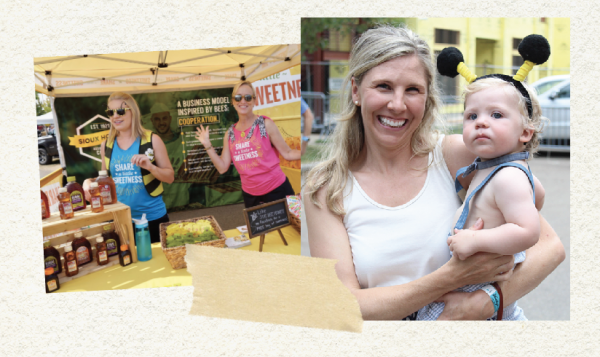
In northern California and up the West Coast, they were battling major forest fires and some of our events were canceled due to heavy smoke, but as we moved through the area we brought cheer where we could and made donations of honey and supplies to the Red Cross.
Texas
 During our road trip, the folks in Texas were devastated by Hurricane Harvey and people on the West Coast wanted to help in some way, so we connected with the Texas Diaper Bank. They needed donations of diapers that they could provide to displaced families, so we worked with grocery stores on our route and conducted a diaper drive at our events. It was so heartening to see people in Spokane, WA, and other areas along the West Coast struggling with their own problems from the fires step up and donate diapers for them, as well.
During our road trip, the folks in Texas were devastated by Hurricane Harvey and people on the West Coast wanted to help in some way, so we connected with the Texas Diaper Bank. They needed donations of diapers that they could provide to displaced families, so we worked with grocery stores on our route and conducted a diaper drive at our events. It was so heartening to see people in Spokane, WA, and other areas along the West Coast struggling with their own problems from the fires step up and donate diapers for them, as well.
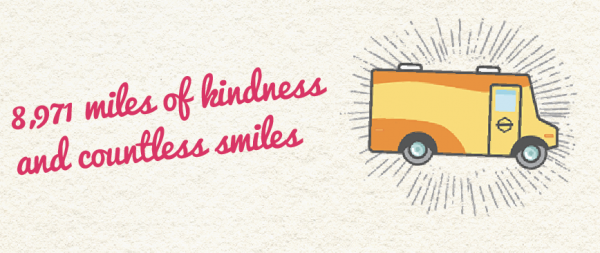
December 27th, 2017
The Propaganda and The Nudge
Why propaganda makes us so angry.
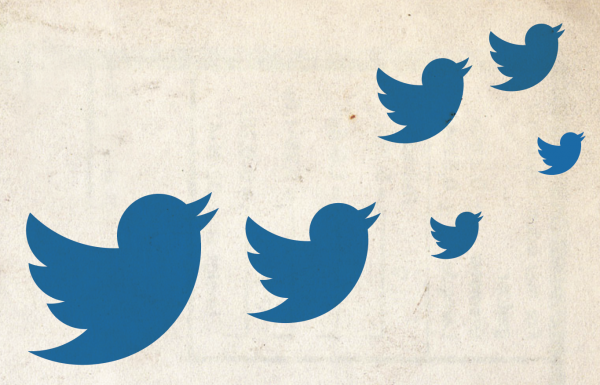 I’ve identified several factors to be considered as to why something as old school as propaganda remains relevant.
I’ve identified several factors to be considered as to why something as old school as propaganda remains relevant.
Part of it can be blamed on the speed of our lives and part on the anonymity of social media. But an important part likely is human psychology, our personal values, and belief systems and biases – all combined with a lack of focus or ability to control our impulses.
As a former journalist and present public relations practitioner, here’s my take.
And so it begins.
Propaganda wasn’t always seen as a negative. Early on, it generally was seen in a positive light because it was helping a worthy cause – think taxation without representation in the American Revolution. But things really changed before World War II. Hitler’s Nazi movement was the propaganda’s piece de resistance, and it led people, many who were basically good, to do unthinkable things.
This is how propaganda lives and grows. It allows others to manipulate us, using short-term goals, half-truths, and logically flawed arguments and comparisons while shouting out their messages with a loud, firm voice and undeniable confidence. These experts play us like the proverbial fiddle to goad us into a strong, negative emotional reaction.
Its power grows.
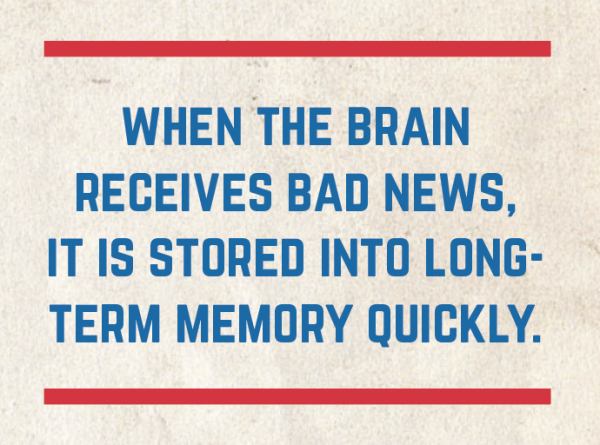
According to a “Psychology Today” article from June 30, 2014, when the brain receives bad news, it is stored into long-term memory quickly. Conversely, positive experiences have to be held in our awareness for more than 12 seconds to transfer from short-term to long-term memory.
This proclivity to highlight negative over positive also impacts our consumption of news content, according to Stuart Soroka, a University of Michigan professor of communication studies and political science. In an Oct. 2017 article, he says the costs of negative information far outweigh the potential benefits of positive information.
A little nudge goes a long way.
Recently, I read with great interest a Washington Post article on the University of Chicago’s Richard Thaler who won the Nobel Prize for economics. Thaler refers to an interesting study about the “urinal fly”—a small, life-like etching of a fly near the drain of a urinal—that led him to the Nobel Prize. The experiment reduced urinal spillage by 80 percent and reduced cleaning costs by 8 percent. He describes the study as his favorite illustration of a “nudge.”
The same principle of the nudge can be applied to the choices, big and small, that people make in their daily lives. For Thaler, a nudge is a choice “that alters people’s behavior in a predictable way without forbidding any options or significantly changing their economic incentives.” Nudges are not mandates, but rather they make it easier to do the right thing.
I think that is a perfect explanation of how advertising and public relations work together for brands. We nudge people to the positive.
If negativity works so well, it might seem illogical for brands to spend millions of dollars each year to highlight their brand’s image, social responsibility or product quality.
But we shouldn’t give into propaganda. Instead, we all should keep nudging the positive. Maybe, we can slowly move toward a reality recognized by early 20th Century American journalist H.L. Mencken, who coined many memorable quotes, including this one: “Truth would quickly cease to be stranger than fiction, once we got as used to it.”

